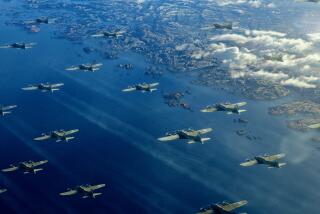Desert Air, Sands Alive With Modern Warriors
THUNDERDOME BASE, Saudi Arabia — In preparation for the ground battle that may still lie ahead, the desert here is alive with movement, a bizarre world of rumbling armor, lumbering supply trucks and careening helicopters crisscrossing the sands and skies of this forbidding northern plain.
From the air, one can understand why these Army helicopter pilots, in naming their desert home, drew inspiration from the film “Mad Max,” about the fictional desert warrior whose battleground was a horrific killing field littered with instruments of death.
A passenger skimming low over the sands in a Blackhawk helicopter at more than 100 m.p.h. sees columns of almost prehistoric-looking M-1A1 tanks rehearsing for combat on the ground, while above, a battalion of fearsome Apache attack helicopters swarms in a “high-energy assault” against an imagined Iraqi enemy.
In the misty distance, more bug-like choppers stand in clusters on the sand, while below, newly vacated encampments seem like ghost towns in the desert. And, most surreal, an Army vehicle lying belly-up, flipped over, miles from any obstacles, its driver and passenger walking shakily away.
While not yet joined in battle, this is an Army on the move, its main units “jumping” northward to new base camps every few days and its combat forces compressing training and clearly spoiling for a fight.
“We’re awaiting our opportunity,” said Lt. Col. Bill Hatch, commander of an Apache helicopter battalion in the 1st Armored Division.
“Wars aren’t usually won,” the 40-year-old flier continued, “until you set a guy down there standing on the ground saying, ‘We own this place.’ ”
The AH-64 Apaches, equipped with laser-guided Hellfire missiles, are the Army’s top-of-the-line attack helicopters and are designed principally for killing tanks. A report by the General Accounting Office last fall criticized the weapons system for what the agency found to be a low level of battle-readiness and excessively high need for maintenance.
But here in Saudi Arabia, where the helicopters could be expected to play a central role in a U.S. ground assault against Iraqi armor, commanders insist they have found the aircraft to be reliable. They say they are confident it will prove its mettle against Iraqi tanks forced into the open by American air attacks and artillery.
“Once they’re moving, you’ll see Apaches being employed both day and night,” one senior officer said.
The pilots in this unit, shipped to Saudi Arabia last month, have had only two weeks in the desert to prepare for combat over forbidding terrain that battalion commander Hatch called “the toughest environment I’ve ever seen for flying.”
Accustomed to the forests, hills and meadows of Central Europe, the newly arrived pilots have found the flatness of the desert to be highly disconcerting, a featureless land in which it can be difficult to distinguish between sand and sky.
“This is a whole new environment for all my aviators,” said the brigade commander, Col. Daniel J. Petrosky. “This is a whole new world.”
Preoccupied in part by the defensive mission against the feared Iraqi attack, the unit did not until a few days ago begin to train in the full battalion-sized units in which it would likely go to battle. With more moonlight soon to return to the night sky, it also hopes to give greater emphasis to night-flying operations.
“We’re ready to exercise our mission,” said Maj. Jim Shivers, the battalion executive officer. “But we’d like to practice more.”
More to Read
Sign up for Essential California
The most important California stories and recommendations in your inbox every morning.
You may occasionally receive promotional content from the Los Angeles Times.










